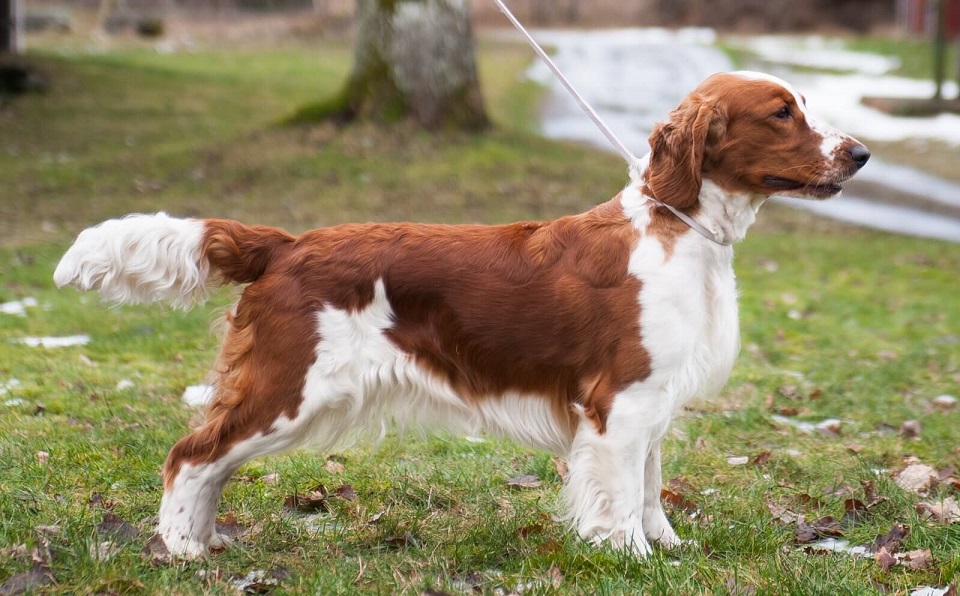
Welsh Springer Spaniel

Navigate through the tabs
Navigate through the tabs below to view the breed's info of your interest.
The breed's info is divided in four sections; namely:
the breed's history ,
the breed's main stats ,
the dog's potential health issues
and finally, how the breed scored in 26 different categories.
All the above information should give you a respectively good overview for the dog of your interest.
Dog Breed's Main Info
The Breed's History:
The actual date of origin of the Welsh Springer Spaniel cannot be traced, however dogs resembling the breed with its distinctive red and white coat are frequently depicted in old pictures and prints. This type of dog was known as the Land Spaniel, and is considered to be similar to the modern Welsh Springer. John Caius, writing in 1570, said "Spaniels whose skynnes are white and if marked with any spottes they are commonly red". It is thought that these Spaniels may have made their way into the Welsh valleys where local sportsman and hunters managed to conserve them in a pure state.
At one time called the Welsh Starter, it was used to spring game, originally for hunters using falcons. The traditional red and white colour of the Welsh Springer was once also found in English dogs, but by the early 20th century any such dogs were considered to have "died out long ago".
The Welsh Springer Spaniel was also at one time called the Welsh Spaniel, and also at one point was included in the Kennel Club (UK) studbook as Cocker Spaniels, and was known as the Welsh Cocker. During the 19th century were several different varieties of Cocker Spaniel, including the English, the Welsh and the Devonshire as the term was used to describe the size of the dog rather than the breed. Unusually, in John George Wood's 1865 book The Illustrated Natural History, an image is described showing a Welsh Cocker Spaniel as a solid coloured dark spaniel.
The same inscription is used in the 1867 work The Dog in Health and Disease by Stonehenge and he further describes the Welsh Cocker and the Devonshire Cocker as "both being of a deep-liver colour". The Welsh Springer was relatively unknown during the 19th Century, but this changed in 1900 when Mr. A. T. Williams of Ynis-y-Gerwn won the team stake at the Sporting Spaniel Club Trials. The trials were held on Mr. Williams' own estate, and it was thought that when his team defeated eight well known teams it was because of the home advantage. This was disproved when dogs from the same kennel went on to win in successive years around the UK. His conformation show champion dog Corrin was the first Welsh Springer Spaniel to be photographed.
Welsh Springers were recognised by The Kennel Club, after the breed had gained popularity, in 1902 under the new name of Welsh Springer Spaniel. Until then the breed was shown alongside the English Springer Spaniel. The Welsh Springer Spaniel was transported to America in the late 19th century and gained recognition by the American Kennel Club in 1906.
World War I caused problems for the breed in the United Kingdom, and when the war was over there were no dogs whose parents had registered pedigrees. The breed restarted with the remaining unregistered dogs, and it is these dogs that formed the modern day breed. The breeders in the 1920s and 1930s developed these dogs into the type of Welsh Springer Spaniel which remains today. The Welsh Springer Spaniel Club (UK) was formed in 1923, registrations slowly increased between the wars but all records held by the breed club were destroyed in an air raid during World War II.
Following the two World Wars, it was thought that no Welsh Springers remained in the United States. The breed was reintroduced, and the descendants of those dogs make up the breed today in the United States and Canada. The breed was officially imported into Australia in 1973.
In 2000, The Kennel Club registered 424 Welsh Springer Spaniels, compared with 12,599 English Springer Spaniels and 13,445 English Cocker Spaniels. Numbers remained steady, with 420 Welsh Springer Spaniels being registered in 2004, however numbers of English Springer Spaniels increased to 14,765 and English Cocker Spaniels to 16,608. Numbers remain closer to the American Cocker Spaniel which registered 610 in 2000, and 599 in 2004. The breed remains more popular than some other breeds of Spaniel, including the Clumber Spaniel, Field Spaniel, Sussex Spaniel and Irish Water Spaniel.
Country of Origin:
Wales
Breed Group:
Sporting
Height:
1 foot, 5 inch. to 1 foot, 7 inch. (43,18 to 48,26 cm)
Weight:
35 to 55 pounds (15,87 to 24,95 Kg)
Life Span:
10 to 15 years
Potential Health Issues:
Entropion,
Hip Dysplasia,
Epilepsy
Adaptability
Apartment Living:
First Time Owners:
Sensitivity:
Being Alone:
Cold Weather:
Hot Weather:
Friendliness
Affection With Family:
With Kids:
With Dogs:
With Strangers:
Health and Grooming
Shedding:
Drooling:
Easy To Groom:
Overall Health:
Weight Gain Potential:
Size:
Training
Easiness:
Intelligence:
Mouthiness:
Prey Drive:
Barking or Howling:
Wanderlust:
Need For Exercise
Energy Level:
Intensity:
Exercise Needs:
Playfulness:
Our Mobile Application
Check out Our Mobile Application "Dog Breeds Central"
